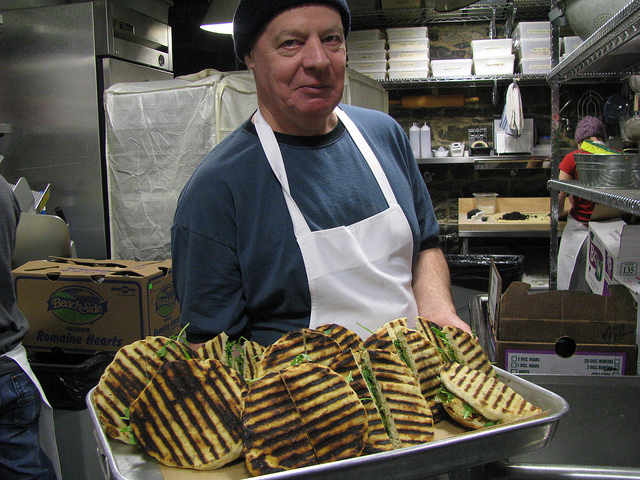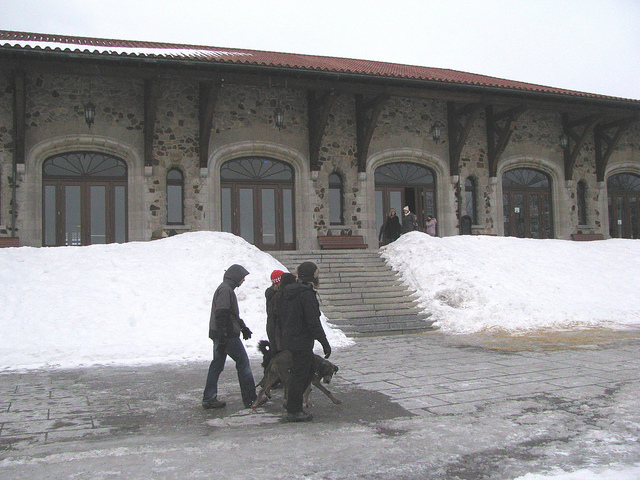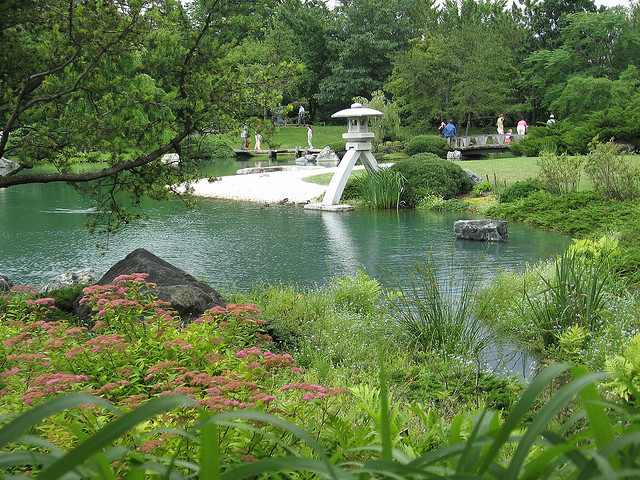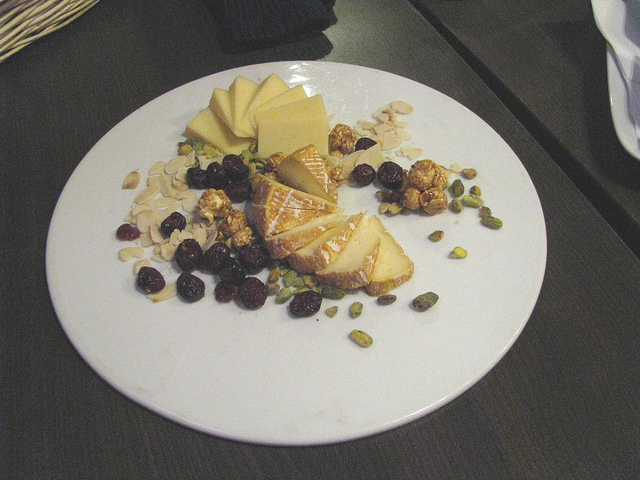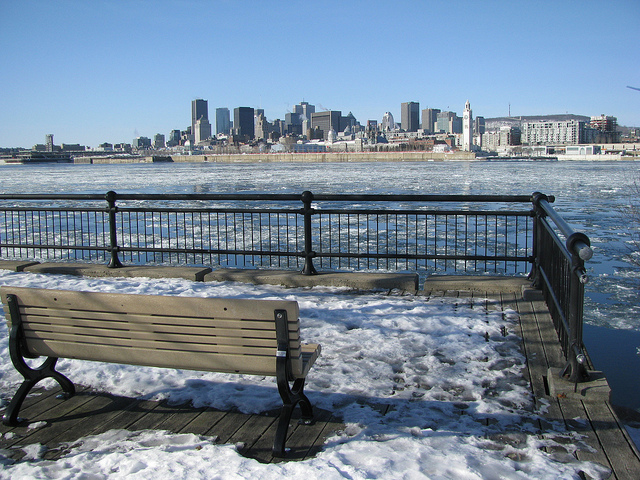During the last few hours in Montreal on Day 5 of our trip (Feb 22, 2011) I managed to get a few more things in. Right after breakfast I received a private tour of the wine cellar of the Restaurant Bonaparte. Co-owner Martin Bédard showed me a huge collection of fine red and white wines that hail from France, Canada, Italy, the United States, Australia, New Zealand and other places. Many of the wines are privately imported, so they are not available through regular retail channels. The restaurant also stocks a wide selection of liquor and champagnes as well as Quebec ice wine, a true delicacy of the region.

Then I started my last visit of Old Montreal by walking a few minutes west from the hotel on Rue St-Paul. I stopped in at “Olive et Gourmando”, a hugely popular café / bakery. Co-owner Dianne Solomon showed me around her establishment which has been in business for almost 14 years. Originally a bakery that sold store-made bread, croissants and coffee, Olive et Gourmando has evolved into a sit-down café that now serves sandwiches, soups, salads, hot dishes as well as wine and beer. Although only open from 8 am to 6 pm from Tuesday to Saturday, the place is usually packed, filled by locals who love the hearty foods offered here as well as by some tourists that stray a little further west in Old Montreal. When she opened her business, Dianne says, the whole area was rather run down and deserted. It is still a bit away from the main tourist drag, but many out-of-towners have also discovered her café.
We took a walk through the kitchen where a large order of fresh vegetables had just been received. Broccoli and cauliflower soup was simmering away, bacon strips were getting ready to be added to various sandwiches; a big vat of melted chocolate was about to become part of some brownies; and a variety of employees were cutting carrots, preparing sandwiches, or washing dishes. Dianne’s dynamic entrepreneurial personality quickly became evident in this walkabout. Today she and her partner manage 35 employees. Even with almost all the tables full at 11 am, Dianne explained that closer to noon the café turns into a real nuthouse: about 450 sandwiches will be sold in about one and a half hours!

In the dining area we said hello to two employees who had the stressful job of putting all the food together; fortunately the sandwiches are already pre-grilled so it doesn’t take long to finish a sandwich in the middle of lunch-time rush hour. The front of the eatery holds all sorts of baked goods including mouth watering treats such as brioches, corn bread, lemon squares, blueberry tarts, brownies and many more. I was definitely planning to come back for lunch here, so I would have a chance to taste some of Olive et Gourmando’s delicacies myself.
Back out on the wintery cool streets of Old Montreal I walked a few more steps to the Place d’Youville, one of the atmospheric squares in this historic part of town. One of the most outstanding buildings here is the Centre d’histoire de Montréal, the city’s history centre, which is housed in an elegant fire station that dates from 1903. I dropped in to find out more about this institution and to learn a bit more about Montreal.
The friendly front-office staff connected me with resident history expert, Tyler Wood, who was gracious enough to spend almost an hour with me to show me through the three levels of this building. This museum contains more than 2,500 historical artefacts and a large collection of photographs and models that really help to bring Montreal’s history to life. The permanent exhibition highlights Montreal in five different eras, from early European contact with the natives all the way into the late 20th century.
To begin our tour we looked at a scale model of Montreal in the lobby which showed the city in 1742, 100 years after its founding. The fortifications had already been torn down, many of the original rivers had been filled in. On the wall above we saw another three-dimensional image that showed Montreal in the 1930s. Always anchored by Mount Royal, the city had grown in all directions, and some high rise buildings had already appeared. The famous Victoria Bridge, an engineering marvel opened in 1859, linked the city across the St. Lawrence River with the South Shore.

Then we explored parts of the permanent exhibition, starting with the era of New France from 1535 to 1759. At that time, Montreal was dominated by French explorers, Catholic settlers from France and the fur trade. By that time, the St. Lawrence Iroquoians who had lived in the area for hundreds of years, had already disappeared, presumably due to warfare with other tribes. Artefacts such as a musket and a scale model of a house tangibly illustrated this pioneering era in Montreal’s history.
In the third room we had a look at the era after confederation in 1867. The mid to late 19th century was the time of the Industrial Revolution when railways and canals were built (including the Lachine Canal). A big model of Montreal illustrates the city in 1889: McGill University was already in existence at that time, founded in 1821 it is one of Canada’s oldest. Lots of factories could be seen along the shores of the St. Lawrence River; and railway lines connected the western provinces of Canada with Montreal’s port where many Canadian products, especially wheat, would be transported onwards. Many of the old factories today have been converted into loft apartments, and a portion of an old Victorian-era neighbourhood called Griffintown still survives, despite many demolitions and highway construction projects.
Tyler went on to explain that Montreal had a very interesting ethnic make-up at that time: many immigrants arrived from Europe – Irish people and Italians as well as immigrants from Eastern Europe: Russians and Eastern European Jews. We saw examples of industrial goods that were made in Montreal at that time: shoes, leather goods, soap, hats, a sewing machine… An IBM punch clock stood as a reminder to Victorian-era factory life. This was the time of child labour and tough working conditions, but it was an era characterized by the beginnings of the labour movement and women’s organizations.
On the second floor we saw an exhibit entitled “Made in Montreal” that featured everyday objects on display that were made in Montreal – or not. A carton of Eaton’s Sunshine Eggs was on display, a Five Roses cookbook, and many other consumer items from the 20th century. Some souvenirs for Expo 1967 were also part of the exhibit, although Tyler indicated that many of the items for this 1967 Canadian world fair were actually made in Japan, not Canada.

The third level, the former attic of the old fire hall, held another fascinating temporary exhibit: “Montreal Moderne”, a tribute to Montreal’s modernist architectural heritage. Three prize-winning photos were on display, two of them showing Montreal’s Olympic Stadium while the third image was of the Olympic Village (the Pyramids). Montreal experienced substantial construction activity during the the 1960s and 1970s, and many modernist buildings dot the city. Some of the most well-known ones include Expo 67, Habitat 67, Place des Nations, the Complex Desjardins, and many more.
Even modernist super-star Ludwig Mies van der Rohe contributed to Montreal’s architectural heritage: he designed Westmount Square, a complex of four office towers in Westmount. The exhibition also featured Roger D’Astous, a well-known Montreal-born architect who designed the Christian Pavilion at Expo 67, and the Chateau Champlain (also sometimes endearingly referred to as the “cheese grater”). Tyler added that these exhibitions allow even out-of-towners to feel like a Montrealer for a day and to understand the city just a bit better.
After this educational outing, a short walk further east on Rue St-Paul took me to the Marché Bonsecours where I had a look at some of the retail stores and stopped in at the Café des Arts at the north end. Owner Michelle Hernandez showed me some of the colourful paintings on display, most of them by local Quebec artists. Photographs by her son adorned the west wall of the café. Michelle is planning to hold a variety of special events and presentations in the next week focusing on healthy living, well-being and even horse-whispering.

Last but not least, I linked up with my travel partner Gary after which we stopped off at Olive et Gourmando where I had a chance to sample the busy cafe’s cuisine. Unfortunately the broccoli soup was already sold out, so I had a hearty vegetable soup and a gourmet salad instead. Michelle had been right: it was about 2 pm now and her cafe was full to the last seat with enthusiastic and hungry customers.
Then it was time to say goodbye to Montreal, grab our suitcases and make our way back to the Bonaventure train station to hop back on the train to Toronto. Via Rail train no. 67 whisked us back to Toronto in less than 5 hours and we had some great chats with the staff on board.

Montreal in the winter has been a wonderful adventure, and I can’t wait to visit the city again.
